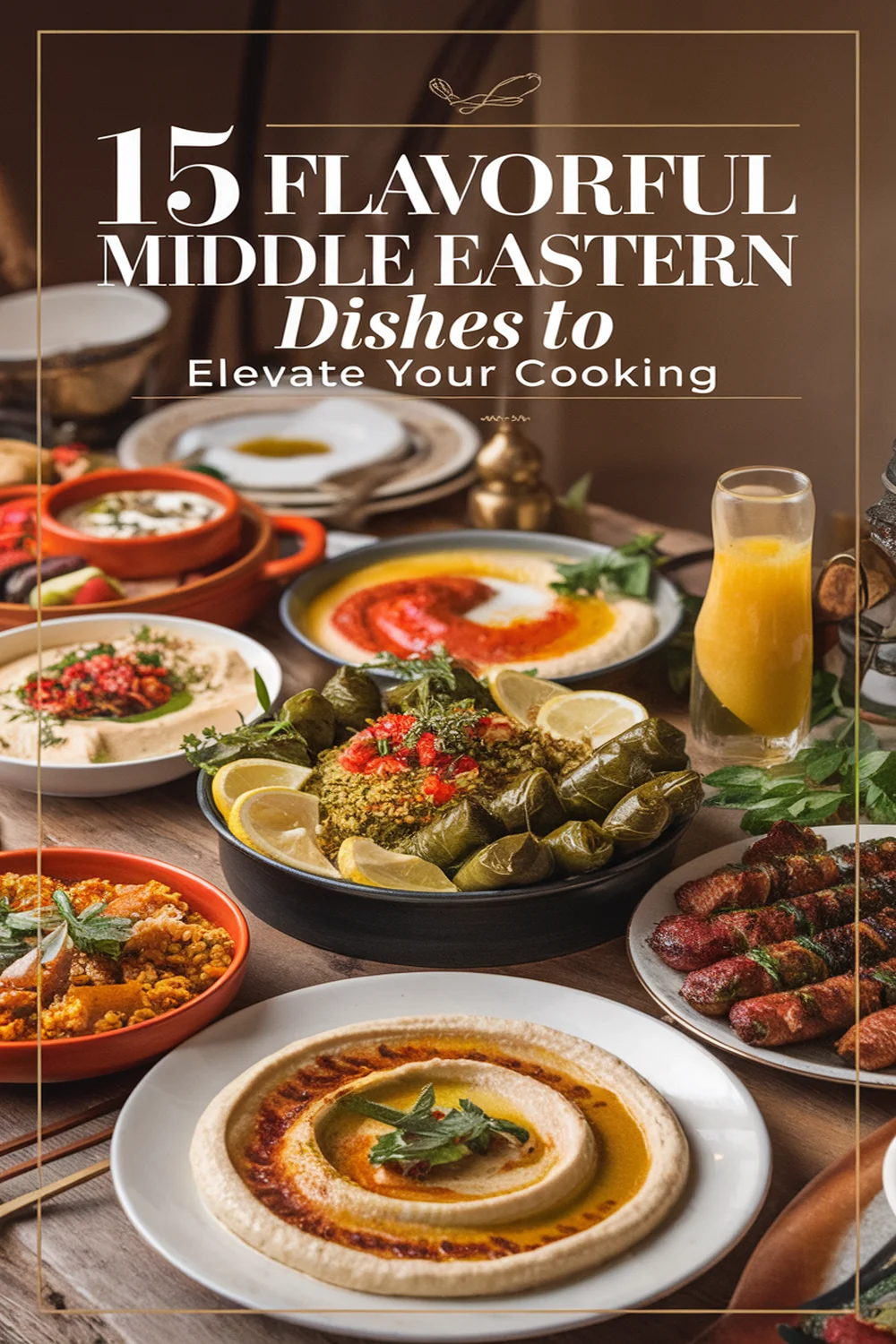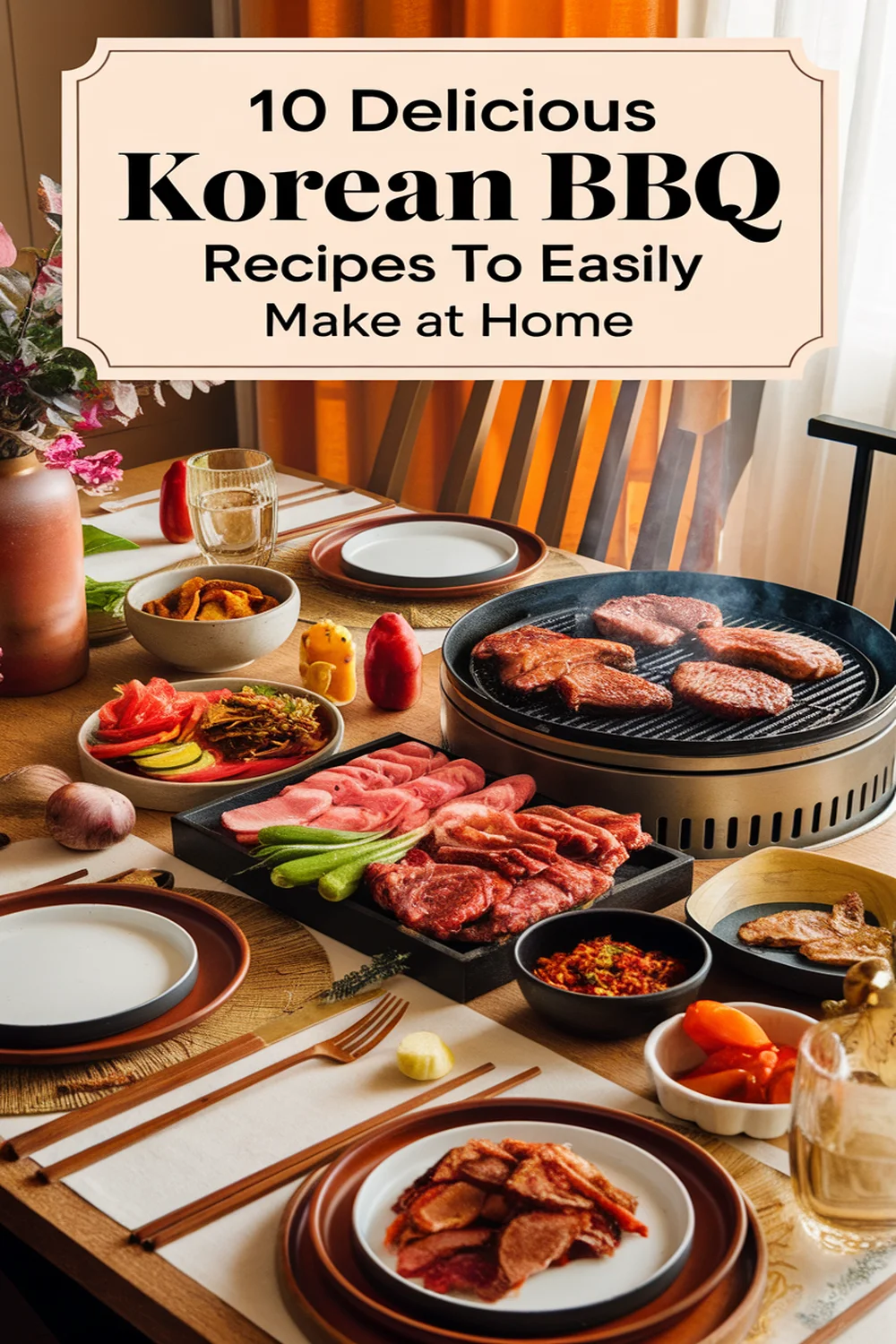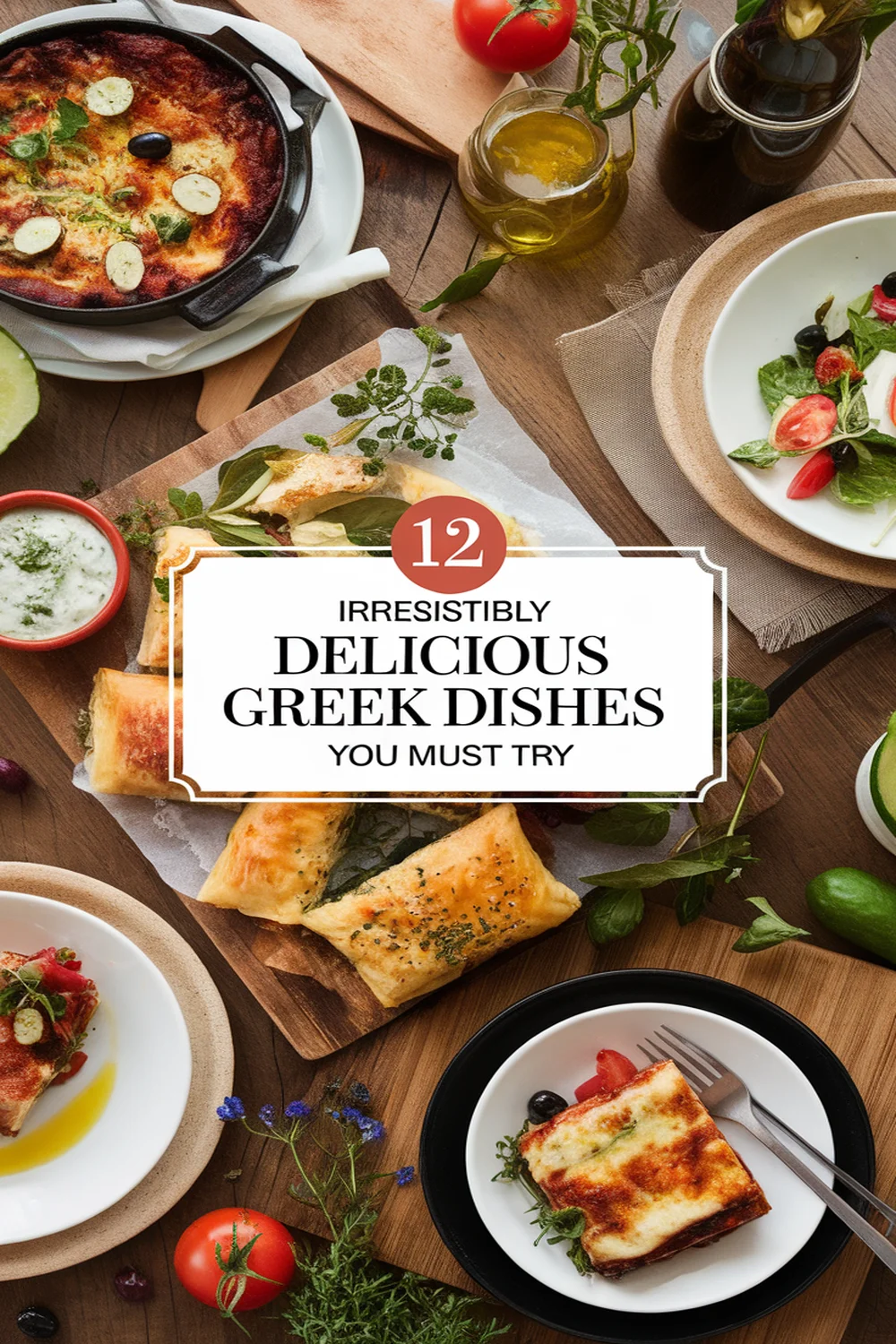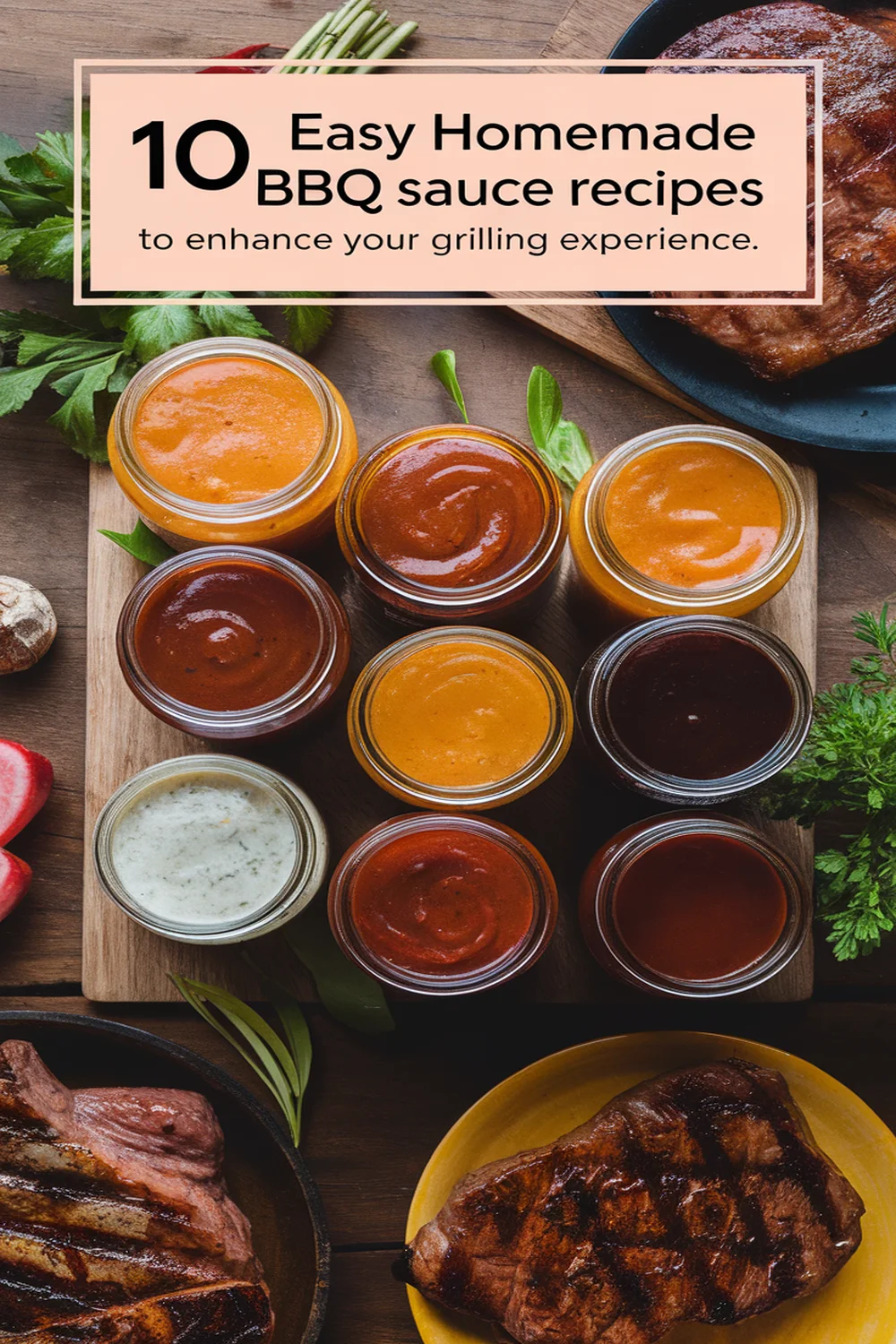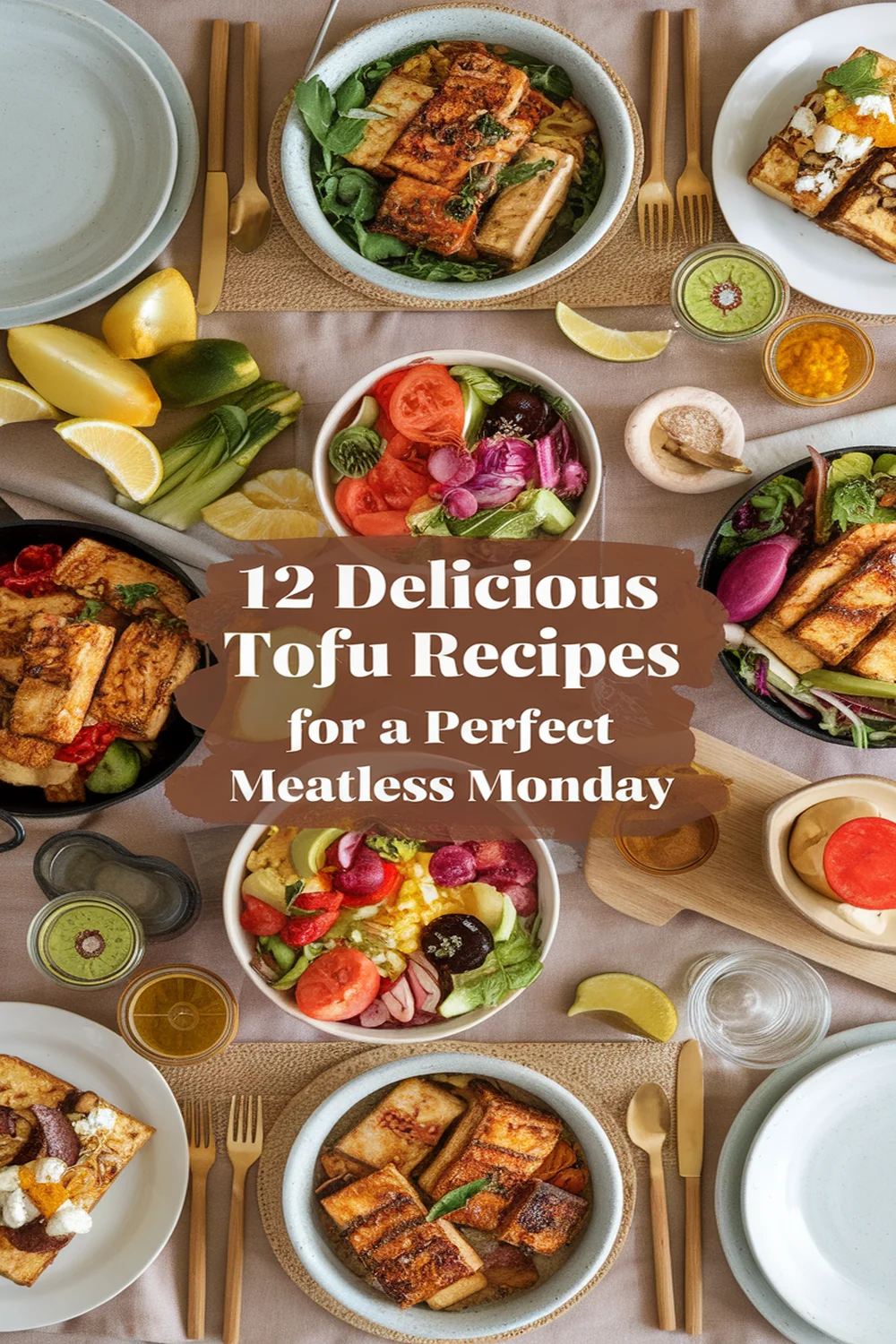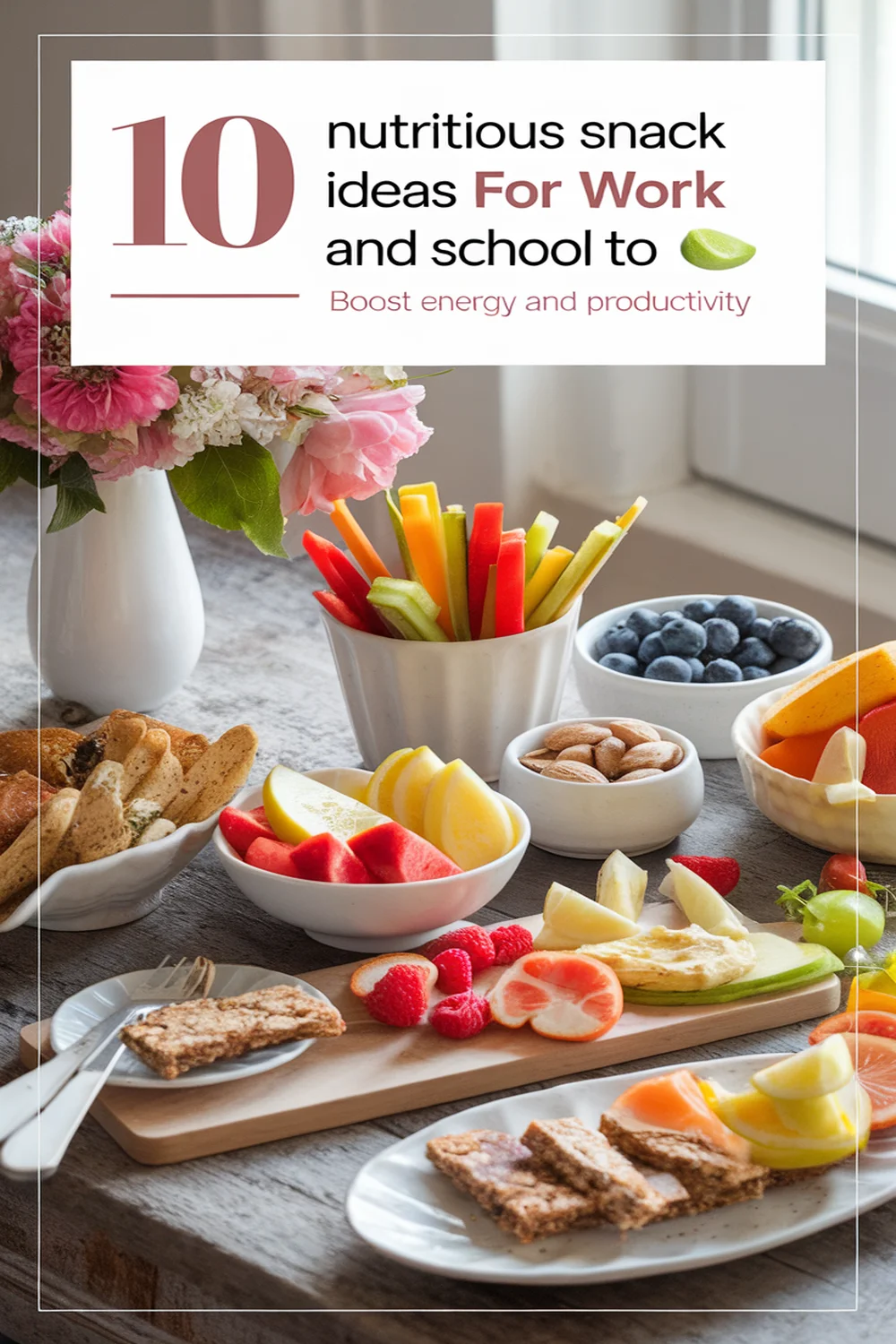This post may contain affiliate links. Please read our policy page.
If you’re looking to elevate your cooking, explore Middle Eastern dishes. Start with creamy hummus for a delicious dip, or try falafel for a crunchy snack. Shawarma adds savory marinated meat to your meals, while invigorating tabouleh offers a vibrant salad option. Don’t miss baba ganoush and moussaka for a smoky dip and hearty casserole, respectively. Finish with sweet qatayef or baklava for dessert. Each dish brings unique flavors; there’s even more to discover if you stick around.
Hummus
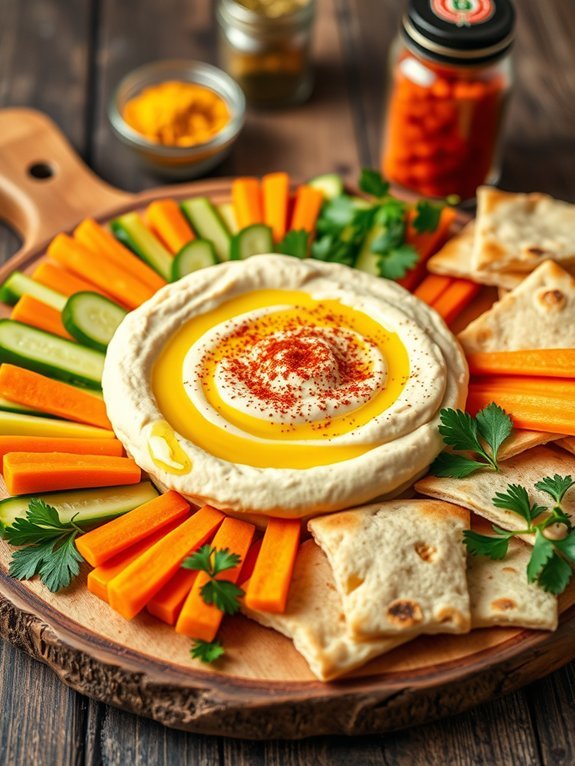
Hummus is a delicious and versatile Middle Eastern dish, loved by many for its creamy texture and rich flavor. Made from chickpeas, tahini, and a blend of spices, it serves as a perfect dip for vegetables, pita bread, or even a spread for sandwiches. Hummus isn’t only a taste sensation but also packed with nutrition, making it a favorite among health-conscious eaters.
The beauty of hummus lies in its ability to be customized with various flavors, from classic garlic to roasted red pepper or even spicy harissa.
To prepare hummus, it’s essential to use high-quality ingredients for the best flavor. While traditional recipes typically require tahini made from toasted sesame seeds, you can also experiment with alternative nut butters for a different twist. Hummus is easy to make and can be whipped up quickly as a convenient snack or appetizer for gatherings. Homemade hummus is fresher and often tastier than store-bought varieties, giving you control over the ingredients and flavors you want to express.
- 1 can (15 oz) chickpeas, drained and rinsed
- 1/4 cup tahini
- 2 tablespoons olive oil
- 2 tablespoons lemon juice
- 1-2 cloves garlic, minced
- 1/2 teaspoon ground cumin
- Salt to taste
- Ice water (as needed for desired consistency)
- Olive oil for drizzling
- Paprika or cayenne pepper for garnish (optional)
- Fresh parsley for garnish (optional)
In a food processor, combine the drained chickpeas, tahini, olive oil, lemon juice, minced garlic, cumin, and salt. Blend the mixture until smooth, scraping down the sides as needed. If the hummus is too thick, gradually add ice water, one tablespoon at a time, until you reach your desired consistency.
Once blended to the right texture, taste and adjust seasoning if necessary. Transfer the hummus to a serving bowl and drizzle some olive oil on top, then sprinkle with paprika or cayenne and garnish with fresh parsley if using.
When making hummus, remember that the quality of the chickpeas and tahini greatly affects the final flavor. If you have time, consider soaking and cooking dried chickpeas for a more authentic taste. Additionally, for an ultra-smooth texture, you can peel the chickpeas before blending.
Don’t hesitate to get creative by adding flavors such as roasted garlic, sun-dried tomatoes, or even avocados for a unique twist on this classic dish. Enjoy your hummus with an array of dippers or as part of a larger mezze platter!
Falafel
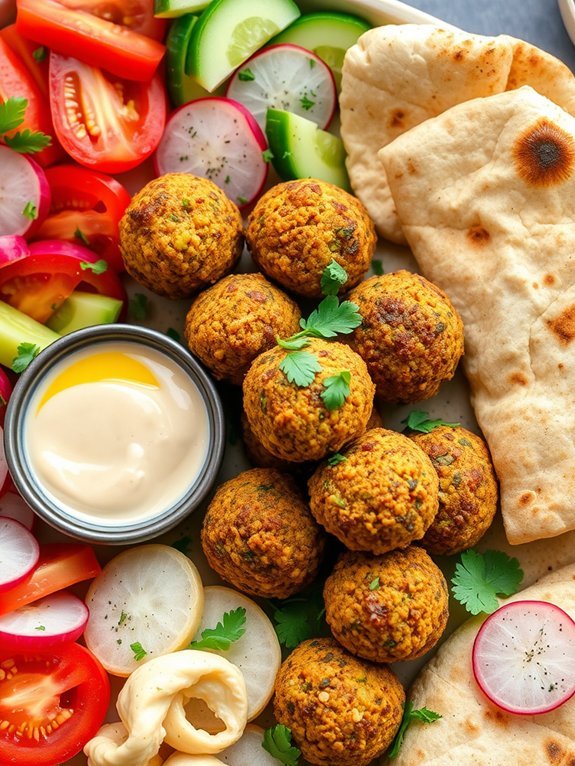
Falafel is a beloved Middle Eastern dish made from ground chickpeas or fava beans mixed with various spices and herbs, then formed into small balls or patties and deep-fried or baked until crispy. Traditionally served in pita bread with vegetables and tahini sauce, falafel isn’t only a popular street food but also a staple in many Middle Eastern dining experiences. Its nutty flavor paired with fresh ingredients makes it a healthy and delicious choice for vegetarians and meat-lovers alike.
Making falafel from scratch can be a rewarding culinary project. The simplicity of its main ingredients allows for substitutions based on personal taste, giving you the freedom to experiment with flavors. Whether you serve it as a snack, appetizer, or main dish, falafel is sure to be a hit among family and friends. With the effort put into preparing these delightful bites, you’ll soon appreciate why it has garnered such a loyal following around the globe.
- 1 cup dried chickpeas (or 1 can, drained)
- 1 small onion, roughly chopped
- 2 cloves garlic, minced
- 1/4 cup fresh parsley, chopped
- 1/4 cup fresh cilantro, chopped
- 1 teaspoon ground cumin
- 1 teaspoon ground coriander
- 1/2 teaspoon baking powder
- Salt and pepper to taste
- Oil for frying (vegetable or canola)
In a food processor, combine the soaked and drained chickpeas with onion, garlic, parsley, cilantro, cumin, coriander, baking powder, salt, and pepper. Process until you have a coarse mixture, but not a paste. Transfer to a bowl, cover, and refrigerate for at least 1 hour.
Once chilled, shape the mixture into balls or patties. Heat oil in a deep skillet over medium heat and fry the falafel until golden brown on all sides, typically about 3-4 minutes.
When preparing falafel, make certain the chickpeas are soaked adequately—the dried ones should sit in water for at least 12 hours to guarantee proper hydration and prevent a grainy texture. If you prefer a healthier option, you can bake the falafel instead of frying; just brush them lightly with oil and bake at 375°F (190°C) for about 25-30 minutes, flipping them halfway through.
Additionally, serving falafel with a variety of fresh toppings such as tomatoes, cucumbers, and pickled vegetables can enhance the flavor and presentation of your dish.
Shawarma
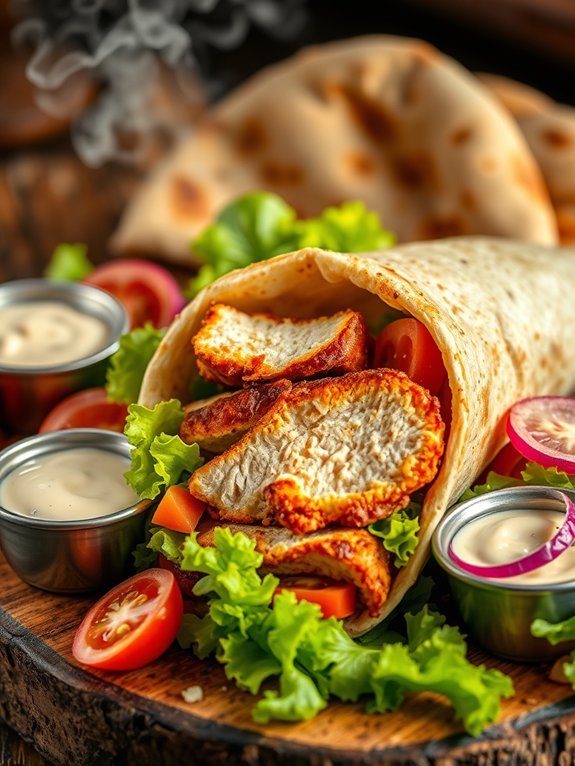
Shawarma is a beloved Middle Eastern dish known for its rich flavors and tender, marinated meat. Traditionally, shawarma is made by stacking seasoned meat on a vertical rotisserie and slow-cooking it, allowing the outer layers to crisp up while the inside remains juicy. Commonly used meats include chicken, lamb, beef, or even turkey, which are marinated in a mix of aromatic spices and sauces like garlic, cumin, coriander, and yogurt. The result is a delightful mix of flavors that can be enjoyed in various ways, such as in a wrap, on a platter with sides, or stuffed in pita bread.
In addition to the savory meat, shawarma is often complemented by an array of toppings and sauces. Fresh vegetables such as tomatoes, cucumbers, and pickled turnips add crunch and freshness, while garlic sauce or tahini brings a creamy texture and tangy flavor. Shawarma is a versatile dish that allows for personalization; you can adjust the toppings and sauces to your preference, making it a favorite for gatherings and meal prep alike.
- 2 pounds of boneless chicken thighs (or beef/lamb)
- 4 cloves of garlic, minced
- 2 tablespoons of ground cumin
- 2 tablespoons of ground coriander
- 1 tablespoon of paprika
- 1 tablespoon of ground turmeric
- 1 tablespoon of cinnamon
- 1 teaspoon of cayenne pepper (optional for heat)
- ½ cup plain yogurt
- ¼ cup olive oil
- Juice of 2 lemons
- Salt and pepper to taste
- Pita bread or wraps for serving
- Fresh vegetables (lettuce, tomatoes, cucumbers, pickled turnips) for toppings
- Garlic sauce or tahini for drizzling
In a large bowl, combine minced garlic, cumin, coriander, paprika, turmeric, cinnamon, cayenne pepper, yogurt, olive oil, lemon juice, salt, and pepper to create a marinade. Add the chicken (or other meat) to the bowl, making sure it’s well-coated, then cover and refrigerate for at least 1 hour, or preferably overnight for deeper flavor.
When ready to cook, preheat your grill, oven, or stovetop skillet over medium-high heat. Cook the marinated meat until it’s fully cooked and has a nice char on the outside, approximately 6-7 minutes on each side for chicken. Once done, allow it to rest for a few minutes before slicing it thinly. Serve with pita bread or wraps, topped with fresh vegetables and your choice of sauce.
When making shawarma at home, marination is key to achieving that authentic flavor; don’t rush this step. For an even greater depth of flavor, try using a combination of meats, like chicken and lamb.
If you don’t have a grill, cooking the meat in an oven on high broil works well too; just keep an eye on it to prevent burning. Additionally, don’t hesitate to experiment with the toppings and sauces based on your taste preferences—each variation can bring a different twist to this classic dish.
Enjoy your homemade shawarma with friends or family for a delightful meal that transports you straight to the heart of the Middle East.
Tabouleh
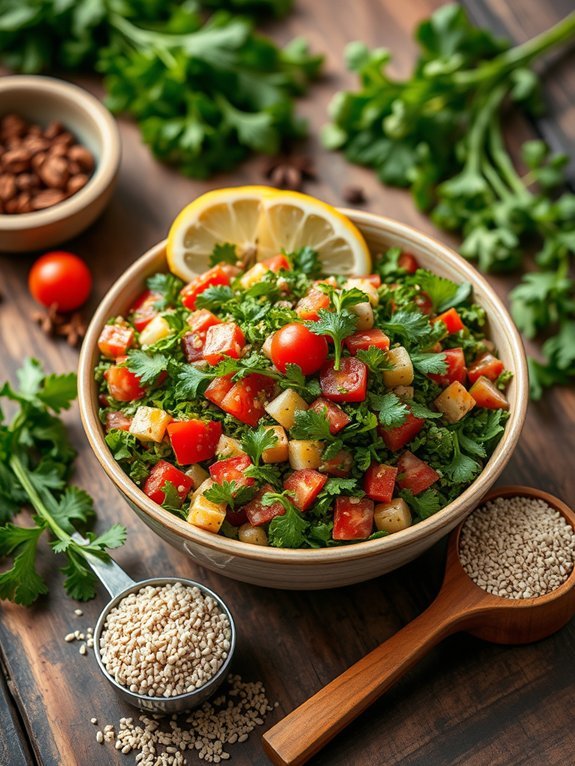
Tabouleh is a vibrant and invigorating salad that originates from the Levant region of the Middle East, particularly Lebanon and Syria. This dish is characterized by its bright green color and zesty flavor profile, making it a favorite accompaniment to many Middle Eastern meals. The key ingredient in tabouleh is finely chopped parsley, which forms the base of the salad, complemented by bulgur wheat, tomatoes, mint, onion, and a tangy dressing of lemon juice and olive oil.
As a dish, it conveys a rich cultural heritage and showcases the use of fresh ingredients that are widely celebrated in Middle Eastern cuisine. In addition to its delicious taste, tabouleh is also highly nutritious, brimming with vitamins and minerals from the fresh vegetables and herbs. It’s often served as a mezze, alongside other small plates, and is perfect for summer gatherings or as an invigorating side dish all year round.
Making tabouleh at home allows you to adjust the ingredients to your liking, whether you prefer a more herbaceous flavor, additional tomatoes, or more lemon kick.
Ingredients:
- 1 cup bulgur wheat
- 2 cups finely chopped parsley
- 1/2 cup finely chopped mint
- 3 medium tomatoes, diced
- 1 small onion, finely chopped
- 1/4 cup olive oil
- 1/4 cup fresh lemon juice
- Salt to taste
Soak the bulgur wheat in cold water for about 30 minutes, or until it softens, then drain and squeeze out any excess water. In a large mixing bowl, combine the chopped parsley, mint, tomatoes, and onion.
Add the soaked bulgur wheat to the bowl, followed by the olive oil and lemon juice. Mix everything together gently until well combined, then season with salt to taste. Allow the tabouleh to sit for about 15 minutes before serving to let the flavors meld.
When preparing tabouleh, using fresh and high-quality ingredients is essential for the best flavor. Make sure to finely chop the herbs and vegetables to achieve that signature texture of the salad. For added zest, you can experiment with the ratio of lemon juice and olive oil, depending on your taste preferences.
Additionally, try serving it chilled to really enhance the invigorating qualities of the dish. If you’re not consuming it immediately, store it in the refrigerator to keep it fresh, but be cautious as the salad can become watery if left too long.
Recommended Items
Ready to dive into the vibrant world of Middle Eastern cooking? Check out our recommended products and equipment to get started!
Products
Baba Ganoush
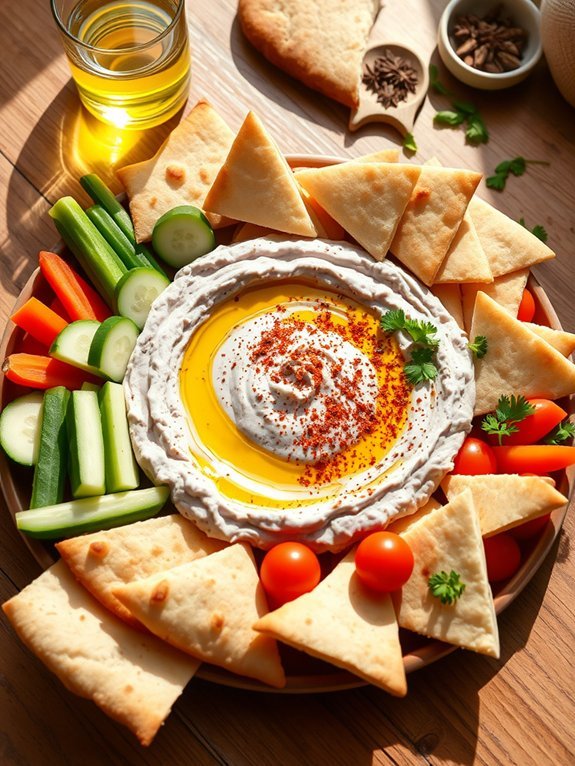
Baba Ganoush is a popular Middle Eastern dip that showcases the rich flavors of roasted eggplant combined with tahini, garlic, and olive oil. This dish isn’t only delicious but also incredibly versatile, making it an ideal appetizer or accompaniment to a variety of meals. The smoky flavor of the eggplant balances perfectly with the creaminess of tahini, resulting in a satisfying and healthy option for your guests or family to enjoy.
To prepare Baba Ganoush, you’ll want to start with fresh, ripe eggplants. The secret to achieving that signature smoky flavor lies in roasting the eggplants until their skin is charred and the flesh is tender. Once they’re roasted and cooled, all you need to do is blend the ingredients together until smooth. The result is a luscious dip that pairs beautifully with pita bread, fresh veggies, or even as a spread on sandwiches.
Ingredients:
- 2 medium eggplants
- 3 tablespoons tahini
- 2 tablespoons olive oil
- 2 cloves garlic, minced
- Juice of 1 lemon
- Salt, to taste
- Optional: chopped parsley for garnish
- Optional: paprika for garnish
Cut the eggplants in half lengthwise and place them on a baking sheet, cut side up. Drizzle them with olive oil and sprinkle with salt, then roast in a preheated oven at 400°F (200°C) for about 30-40 minutes, or until the flesh is soft and the skin is charred.
Remove from the oven and let cool. Once cooled, scoop the flesh out of the eggplant skins and place it in a food processor. Add tahini, garlic, lemon juice, and a pinch of salt, and blend until smooth. Drizzle in olive oil while blending, adjusting seasoning to taste.
Serve chilled, garnished with chopped parsley and a sprinkle of paprika if desired.
When making Baba Ganoush, choosing the right eggplant is key – look for firm, glossy skin without blemishes for the best flavor. You can also adjust the garlic and tahini levels to suit your taste preferences.
If you want an extra smoky flavor, consider charring the eggplants directly on a grill or open flame before blending. Additionally, let the dip rest for a little while before serving; this will allow the flavors to mingle and deepen, creating a more harmonious taste. Enjoy this delightful dish with an assortment of accompaniments for a perfect culinary experience!
Dolma
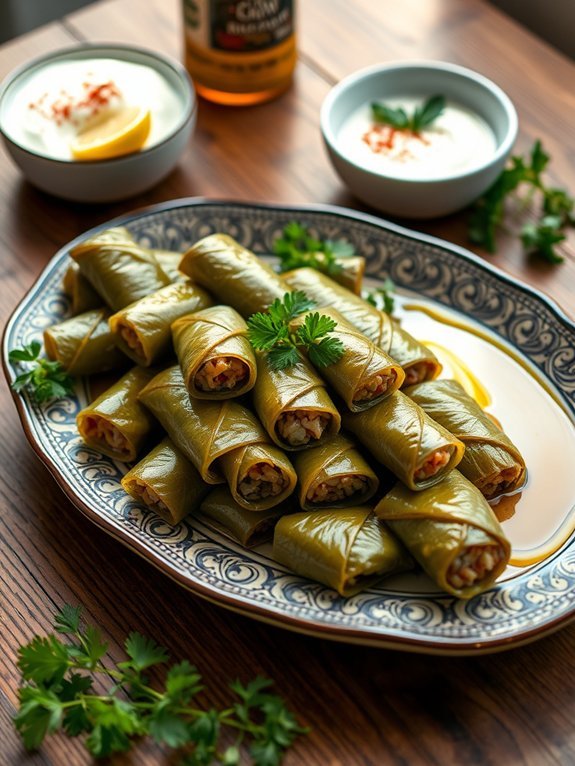
Dolma is a delectable dish that has its roots in Middle Eastern cuisine, specifically popular in countries such as Turkey, Greece, and Lebanon. It typically consists of grape leaves stuffed with a mixture of rice, herbs, and spices, though variations exist that incorporate meats and different fillings. The word “dolma” translates to “stuffed” in Turkish, a fitting name for this beloved dish that can be served as an appetizer or main course, and is often accompanied by yogurt or a tangy sauce.
Making dolma is a wonderful culinary adventure that combines aromatic flavors with the artistry of rolling into neat little packages. The key to a perfect dolma lies in the fresh and high-quality ingredients, along with the right balance of spices that create an inviting aroma and a burst of flavor in every bite. Whether you’re an experienced cook or a beginner, you’ll find joy in preparing these delightful morsels that embody the essence of Middle Eastern hospitality.
Ingredients:
- 1 jar of grape leaves (about 60 leaves)
- 1 cup of rice, rinsed
- 1 large onion, finely chopped
- 1/2 cup of fresh parsley, chopped
- 1/4 cup of fresh dill, chopped
- 1/4 cup of fresh mint, chopped
- 1 teaspoon of ground cinnamon
- 1 teaspoon of allspice
- 1/4 cup of olive oil
- 1 lemon, juiced
- 1 teaspoon of salt
- 1/2 teaspoon of black pepper
- 2 cups of vegetable or chicken broth
Start by preparing the grape leaves. If using preserved leaves, rinse them under cold water to remove excess brine and set aside. In a skillet, heat the olive oil over medium heat and sauté the chopped onion until translucent.
Then add the rice, parsley, dill, mint, cinnamon, allspice, salt, and pepper to the skillet and mix well, allowing the rice to absorb the flavors for about 5 minutes. Remove from heat and let the mixture cool slightly.
Take one grape leaf at a time, placing the stem end towards you, and spoon about a tablespoon of the rice mixture onto the leaf. Roll the leaf tightly from the stem end, tucking in the sides to create a neat package. Repeat until all the filling is used.
Place the dolmas seam-side down in a pot, cover with the remaining grape leaves, pour the lemon juice and broth over them, and simmer on low for about 45 minutes until the leaves are tender and the rice is cooked.
When making dolma, be sure not to overfill the grape leaves, as the filling expands while cooking. If you want to add a richer flavor, consider using a combination of rice and minced meat.
Feel free to experiment with various herbs according to your preference; though traditional recipes often use parsley and dill, adding cilantro or basil can provide a unique twist.
Ultimately, serving dolma chilled or at room temperature with a side of yogurt or a lemony sauce enhances the flavor and adds a revitalizing element to the dish. Enjoy your culinary creation!
Kebabs
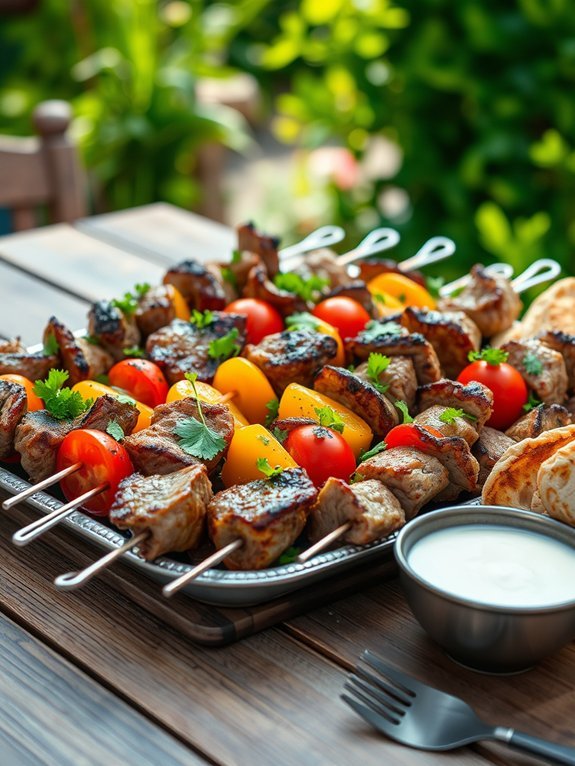
Kebabs have a rich culinary history in the Middle East, beloved for their smoky flavors and tantalizing spices. These skewered meats can be made from various proteins such as lamb, beef, chicken, or even fish, marinated in a delectable blend of spices and herbs.
The grilling process adds an irresistible char, making kebabs a favorite for outdoor gatherings and family feasts alike. The beauty of kebabs lies not only in the delicious meat but also in the variety of accompaniments, ranging from fresh salads to warm pita bread.
To create the perfect kebab, a good marinade is essential. Traditional spices like cumin, coriander, and paprika infuse the meat with flavor, while garlic and onion provide aromatic depth.
Whether you choose to grill, broil, or pan-sear your kebabs, they can easily be adapted to suit your cooking method of choice. Serve your kebabs with a sprinkle of fresh herbs and a squeeze of lemon for brightness, and you’ll have a dish that’s both flavorful and visually appealing.
- 1 lb of meat (lamb, beef, chicken, or vegetable alternatives)
- 2 tablespoons olive oil
- 2 teaspoons ground cumin
- 2 teaspoons paprika
- 1 teaspoon ground coriander
- 1 teaspoon salt
- 1 teaspoon black pepper
- 3 cloves garlic, minced
- 1 medium onion, finely chopped
- Juice of 1 lemon
- Fresh herbs (like parsley or cilantro), for garnish
- Skewers (metal or soaked wooden)
Cut the meat into uniform cubes, about 1 inch each, and place in a large bowl. In a separate bowl, combine the olive oil, spices, salt, pepper, garlic, onion, and lemon juice to create a marinade.
Pour the marinade over the meat, ensuring it’s evenly coated. Cover and let marinate in the refrigerator for at least 1 hour, or overnight for more intense flavors.
When ready to cook, thread the marinated meat onto the skewers and grill over medium-high heat for about 10-15 minutes, turning occasionally, until golden brown and cooked to your desired level of doneness.
For an extra kick of flavor, consider adding a touch of yogurt to your marinade to help tenderize the meat. You can also experiment with various vegetables on the skewers, like bell peppers, onions, or cherry tomatoes, for added color and taste.
Let the kebabs rest for a few minutes after cooking for juicier results, and don’t forget to serve them with tasty dips like tzatziki or garlic sauce to make your meal even more special.
Mujadara
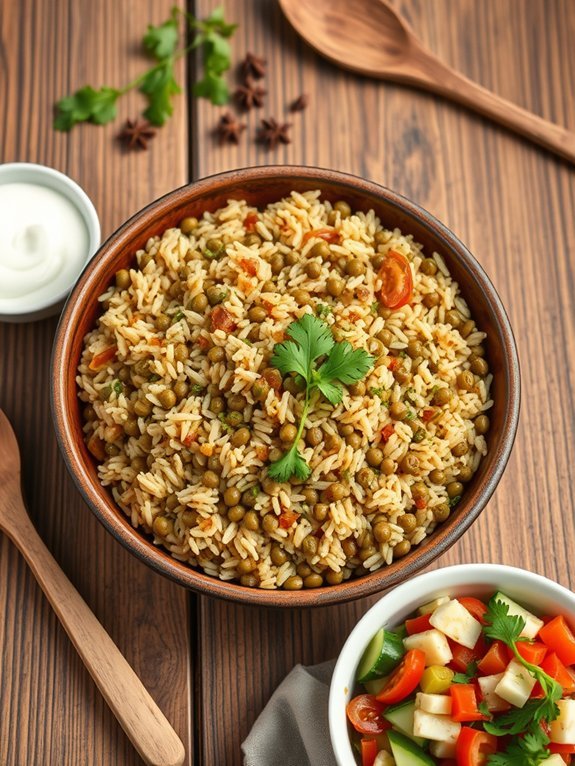
Mujadara is a classic Middle Eastern dish that beautifully combines earthy flavors and textures, making it a comforting and hearty meal. The dish primarily consists of lentils, rice, and caramelized onions, which come together to create a flavorful and nutritious offering. Originating from various countries in the region, Mujadara is often served with a side of yogurt or a fresh salad, making it versatile and appealing to a wide range of tastes.
The beauty of Mujadara lies in its simplicity, which allows the individual ingredients to shine. The lentils and rice blend together to create a satisfying base, while the sweet, caramelized onions add depth and complexity to the dish.
Whether you’re looking for a filling vegetarian option or a side dish to accompany your main meal, Mujadara is an excellent choice that’s both easy to prepare and enjoyable to eat.
- 1 cup green or brown lentils
- 1 cup basmati rice
- 2 large onions, thinly sliced
- 3 tablespoons olive oil
- 4 cups water or vegetable broth
- 1 teaspoon cumin
- Salt and pepper to taste
- Fresh parsley for garnish (optional)
In a large pot, heat the olive oil over medium heat and add the sliced onions. Cook the onions slowly, stirring occasionally, until they become caramelized and golden brown, which usually takes about 15-20 minutes. Once the onions are ready, remove half of them from the pot and set aside for garnishing later.
Add the lentils, rice, cumin, and salt and pepper to the pot with the remaining onions. Pour in the water or vegetable broth, bring to a boil, then reduce the heat to low. Cover and simmer for about 20-25 minutes, or until the lentils and rice are cooked through and the liquid is absorbed. Fluff the mixture with a fork before serving and top with the reserved caramelized onions.
To enhance the flavor of the Mujadara, consider soaking the lentils for a few hours before cooking; this can help them cook more evenly and reduce cooking time. Additionally, experimenting with different spices such as coriander or smoked paprika can add an interesting twist to the classic recipe.
If you’re preparing this dish ahead of time, it can also be stored in the refrigerator for a few days, making it a great option for meal prep. Garnish each serving with fresh parsley to brighten the dish and add a touch of freshness.
Fattoush
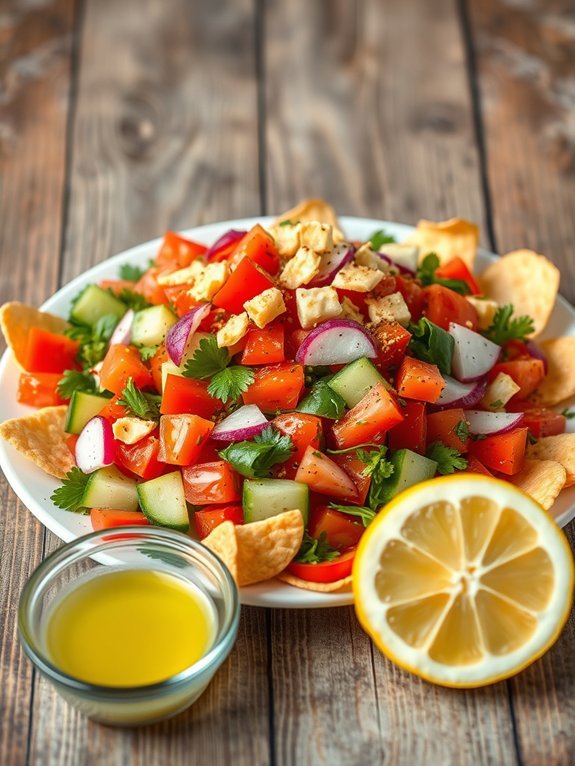
Fattoush is a vibrant and invigorating Middle Eastern salad that showcases the flavors of seasonal vegetables and crispy pita bread. It hails from Lebanon and is a staple in many Arabic households. The dish is primarily composed of chopped vegetables like tomatoes, cucumbers, radishes, and bell peppers, all tossed with pieces of toasted or fried pita bread. The dressing, made from fresh lemon juice, olive oil, and a hint of sumac, adds a tangy and aromatic flavor that perfectly complements the fresh ingredients.
One of the appealing aspects of Fattoush is its versatility. You can easily customize it by adding other ingredients such as parsley, mint, or even grilled chicken to suit your preferences. Traditionally served as a starter, Fattoush is also a lovely accompaniment to grilled meats and can be enjoyed year-round, making it a favorite among many.
Ingredients:
- 2 pita breads
- 1 large tomato, diced
- 1 cucumber, diced
- 1 bell pepper, diced
- 1 radish, thinly sliced
- 1/2 cup chopped parsley
- 1/4 cup mint leaves, chopped
- 1 small red onion, thinly sliced
- 3 tablespoons olive oil
- 2 tablespoons fresh lemon juice
- 1 teaspoon sumac
- Salt and pepper to taste
To prepare the Fattoush, start by preheating the oven to 375°F (190°C). Cut the pita breads into triangles and lightly brush them with olive oil before placing them on a baking sheet. Bake in the oven for 10-12 minutes, until they’re golden and crispy.
In a large mixing bowl, combine the diced tomatoes, cucumber, bell pepper, radish, red onion, parsley, and mint. Once the pita chips are ready, let them cool slightly and then break or crumble them into the salad.
In a separate bowl, whisk together the olive oil, lemon juice, sumac, salt, and pepper, then pour this dressing over the salad and toss everything gently to combine.
When making Fattoush, feel free to experiment with the ingredients based on what’s in season or what you have on hand. Using day-old bread instead of fresh pita can give the salad a delightful crunch, while adding ingredients like pomegranate seeds or walnuts can enhance both texture and flavor.
For the best taste, serve Fattoush shortly after preparing it, as the pita bread remains crispy and the salad stays fresh. If making ahead, keep the pita chips and salad components separate until ready to serve.
Kofta
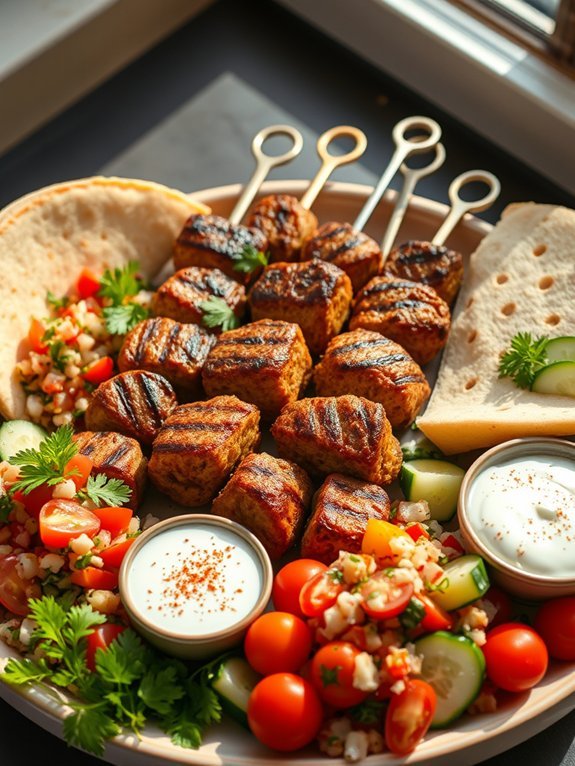
Kofta is a traditional Middle Eastern dish that features spiced ground meat formed into cylindrical shapes, which can be grilled, baked, or fried. This dish is beloved for its deliciously complex flavors and versatility, as it can be made with different types of meat such as lamb, beef, or chicken, depending on personal preference.
The mixture is typically seasoned with a variety of spices, herbs, and onions, giving it a vibrant taste that pairs wonderfully with a range of side dishes, dips, and sauces. Kofta is usually served with pita bread, fresh vegetables, or rice, and can be accompanied by yogurt sauce or tahini for added creaminess. It’s a popular choice for gatherings and special occasions due to its ability to please a crowd.
Furthermore, making kofta can be an engaging activity, inviting friends and family to join in the preparation and enjoy the resulting culinary creation together.
Ingredients:
- 1 pound ground lamb or beef
- 1 small onion, finely grated
- 2 cloves garlic, minced
- 1 teaspoon ground cumin
- 1 teaspoon ground coriander
- 1 teaspoon ground allspice
- 1 teaspoon paprika
- 1/2 teaspoon cayenne pepper (optional)
- 1/2 cup fresh parsley, chopped
- Salt and pepper to taste
- 1 tablespoon olive oil (for grilling)
- Pita bread (for serving)
To cook the kofta, combine the ground meat with the onion, garlic, cumin, coriander, allspice, paprika, cayenne, parsley, salt, and pepper in a large bowl. Mix well until all ingredients are evenly incorporated. Shape the mixture into elongated, cylindrical shapes, about the size of sausages.
Preheat your grill or pan over medium-high heat, then lightly oil the surface. Grill the kofta for about 8-10 minutes, turning occasionally, until they’re browned and cooked through.
When making kofta, be certain not to overmix the meat mixture, as this can result in tougher kofta. Allow the shaped kofta to rest for about 15 minutes before cooking to help them hold their shape better. Additionally, feel free to customize the spices and herbs to suit your taste, as kofta recipes can vary greatly by region and tradition.
If grilling, soak wooden skewers in water for about 30 minutes to prevent burning. Enjoy this delightful dish as part of a festive meal!
Proposed Recipe
Shakshuka
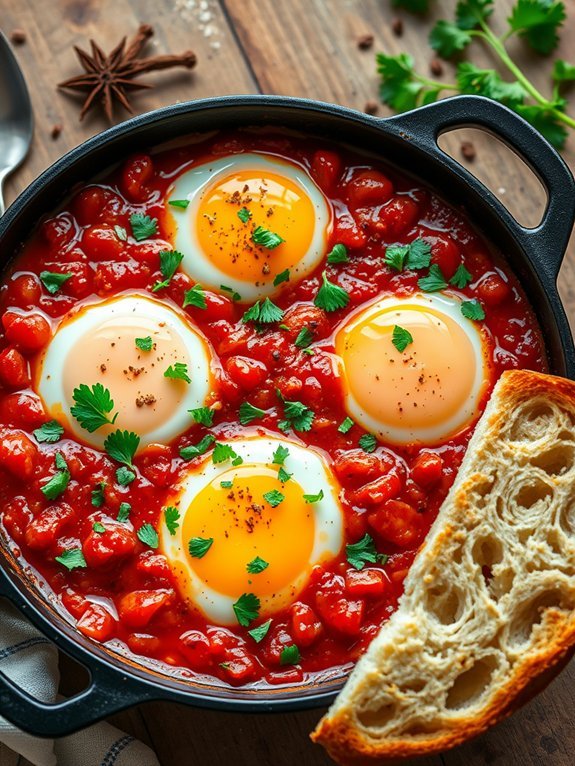
Shakshuka is a flavorful and comforting dish that originates from North Africa but is now popular across the Middle East. It consists of poached eggs simmered in a spicy, aromatic sauce made primarily with tomatoes, peppers, and onions, all seasoned with a delightful array of spices. This vibrant meal isn’t only wholesome but also versatile, making it perfect for breakfast, brunch, or even dinner. Shakshuka is often served with crusty bread, allowing you to soak up the delicious sauce and runny egg yolks.
To make a traditional Shakshuka, the key is to use fresh, quality ingredients. The base of the dish is a rich tomato sauce flavored with onions, garlic, and bell peppers, often accented with spices like cumin and paprika. Once the sauce is prepared, the eggs are cracked directly into the pan and poached until they’re tender, resulting in a beautiful combination of colors and textures.
Whether you enjoy it mildly spiced or with a fiery kick, this dish can be tailored to your taste preferences while keeping the essence of its origins.
Ingredients:
- 2 tablespoons olive oil
- 1 onion, diced
- 1 red bell pepper, diced
- 2 garlic cloves, minced
- 1 teaspoon ground cumin
- 1 teaspoon paprika
- 1 can (14 oz) crushed tomatoes
- Salt and pepper, to taste
- 4 eggs
- Fresh parsley or cilantro, for garnish
- Crusty bread, for serving
In a large skillet, heat the olive oil over medium heat. Add the diced onion and bell pepper, seasoning with a pinch of salt, and sauté until the vegetables are softened, about 5-7 minutes.
Stir in the garlic, cumin, and paprika, cooking for an additional minute until fragrant. Pour in the crushed tomatoes, season with salt and pepper, and let the sauce simmer for about 10 minutes until it thickens slightly.
Create four wells in the sauce and gently crack each egg into a well. Cover the skillet and cook for 5-7 minutes or until the eggs are set to your liking. Garnish with fresh parsley or cilantro before serving with crusty bread on the side.
When preparing Shakshuka, feel free to customize the dish with additional toppings such as crumbled feta cheese, sliced olives, or your favorite hot sauce for added heat.
If you prefer a chunkier texture, consider using diced fresh tomatoes instead of canned. Also, be mindful of the cooking time for the eggs; if you enjoy runny yolks, keep a close watch on them as they poach.
To elevate the dish further, adding a splash of harissa or other chili pastes can give it a nice spicy kick!
Moussaka
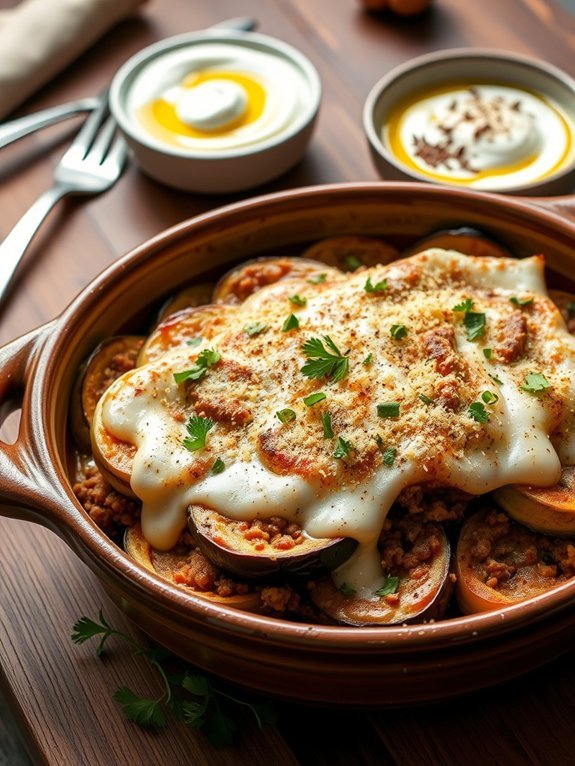
Moussaka is a classic Middle Eastern dish that has captured the hearts and taste buds of food lovers around the world. It’s a layered casserole that commonly features ingredients such as eggplant, ground meat, and a creamy béchamel sauce. Each region has its own twist on the preparation, but the essence remains the same—a delightful combination of flavors and textures that create a comforting and satisfying meal.
This dish is perfect for a family gathering or a special occasion, as it not only tastes divine but also looks enticing when served.
To prepare Moussaka, you’ll start by layering slices of roasted eggplant and spiced ground meat, often seasoned with garlic, onion, and a pinch of spices like cinnamon or nutmeg. The final layer features a rich béchamel sauce, which adds a creamy element that beautifully complements the savory layers below.
This dish can be a bit time-consuming, but the investment in time yields a meal that’s sure to impress.
Ingredients:
- 2 large eggplants
- 500g ground beef or lamb
- 1 onion, chopped
- 2 cloves of garlic, minced
- 400g canned tomatoes, crushed
- 2 tablespoons olive oil
- 1 teaspoon ground cinnamon
- Salt and pepper to taste
- 4 tablespoons chopped fresh parsley
- 2 cups milk
- 2 tablespoons butter
- 2 tablespoons all-purpose flour
- 1 large egg
- Grated Parmesan cheese for topping
Preheat your oven to 200°C (400°F). Slice the eggplants into rounds, sprinkle lightly with salt, and let them sit for about 30 minutes to draw out excess moisture. In the meantime, heat olive oil in a skillet and sauté the onion and garlic until translucent.
Add the ground meat, cooking until browned, then incorporate the crushed tomatoes, cinnamon, salt, pepper, and parsley. Allow the mixture to simmer for about 15 minutes. Once the eggplant has released its moisture, rinse and pat dry. Roast the slices in the oven until golden.
For the béchamel sauce, melt butter in a saucepan, whisk in flour to form a roux, and gradually add in milk while stirring to thicken. Remove from heat and whisk in the egg, then spread a layer of meat followed by eggplant in a baking dish, and top with the béchamel and grated cheese. Bake for 30-40 minutes until golden.
When cooking Moussaka, let it rest for at least 15-20 minutes after pulling it from the oven to help the layers set. This can make slicing considerably easier and guarantees that the juices redistribute throughout the dish, enhancing the flavor.
Don’t hesitate to customize the recipe with your favorite herbs or variations of meat, and remember that Moussaka also tastes even better the next day, so consider making it ahead of time!
Qatayef
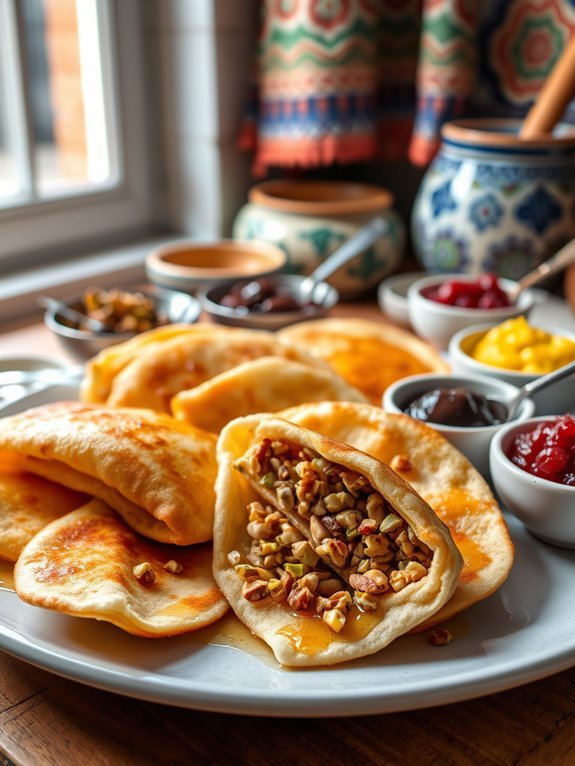
Qatayef is a beloved Middle Eastern dessert, traditionally enjoyed during the holy month of Ramadan. These delectable stuffed pancakes can be filled with a variety of sweet ingredients, such as nuts, cheese, or sweetened cream, and are often dipped in syrup for an added layer of flavor.
The origins of qatayef trace back to the Ottoman Empire, and they remain a popular treat among many Middle Eastern cultures, served during festive occasions and gatherings.
The dish features a unique batter that results in soft, fluffy pancakes that are cooked only on one side. Once filled, they can be shaped into delightful parcels and fried or baked until golden. This recipe simplifies the process, enabling you to enjoy this special treat at home and share it with family and friends.
Ingredients:
- 1 cup all-purpose flour
- 1/2 cup semolina
- 1 tablespoon sugar
- 1/2 teaspoon baking powder
- 1/2 teaspoon yeast
- 1 1/4 cups warm water
- 1/2 cup finely chopped nuts (such as walnuts or pistachios)
- 1/2 cup sweetened cream cheese or ricotta
- 1/4 cup simple syrup (optional, for serving)
- Oil for frying (if frying)
In a mixing bowl, combine the flour, semolina, sugar, baking powder, and yeast. Gradually whisk in the warm water until you achieve a smooth batter. Let the batter rest for about 30 minutes.
Heat a non-stick skillet over medium heat, and pour a small amount of batter (about 2-3 tablespoons) into the skillet, cooking until bubbles form and the edges appear set, about 2-3 minutes. Don’t flip; remove from the skillet and allow to cool slightly.
Once cooled, fill half of each pancake with the nut mixture or cream cheese, fold over, and pinch the edges to seal. Fry or bake until golden, then serve with simple syrup if desired.
For a unique twist, consider experimenting with different fillings such as chocolate, fruit preserves, or even a combination of sweet and savory ingredients.
If frying, make sure the oil is hot enough to create a crispy texture without absorbing too much fat. Additionally, if you opt for baked qatayef, brush them lightly with butter before baking for an extra crisp. Enjoy your homemade qatayef fresh out of the oven or fryer for the best taste!
Rice Pilaf
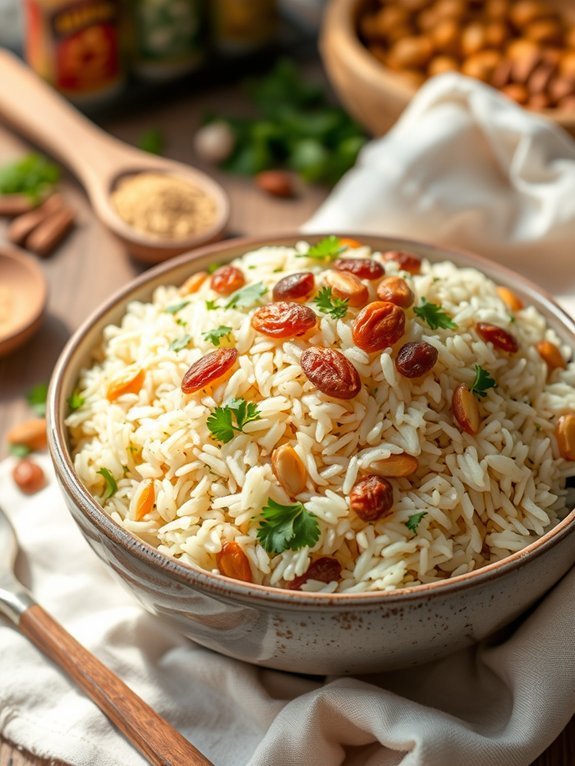
Rice pilaf is a beloved dish across the Middle East, known for its aromatic flavors and versatility. This fragrant rice dish is often infused with spices, herbs, and sometimes adorned with nuts and dried fruits. It serves as a perfect accompaniment to various meat dishes, or it can be enjoyed on its own as a wholesome vegetarian option. The cooking technique of sautéing the rice before boiling enhances its nutty flavor and allows for a fluffy texture.
The beauty of rice pilaf lies in its flexibility to incorporate different ingredients based on seasonal availability or personal preference. From adding vegetables like peas or carrots to including rich protein options, the possibilities are endless. Additionally, cooking pilaf in broth rather than water deepens the flavors, making every bite memorable. Whether you’re hosting a dinner party or simply enjoying a meal at home, a well-prepared rice pilaf can elevate your dining experience.
- 1 cup long-grain rice
- 2 tablespoons olive oil or butter
- 1 small onion, finely chopped
- 2 cloves garlic, minced
- 2 cups vegetable or chicken broth
- 1 teaspoon cumin
- 1 teaspoon salt
- ½ teaspoon black pepper
- Optional: ½ cup toasted almonds or pine nuts
- Optional: ½ cup dried fruits (like raisins or apricots)
- Fresh parsley for garnish
In a pot, heat the olive oil or butter over medium heat and sauté the chopped onion until translucent. Add the minced garlic and sauté for another minute until fragrant. Stir in the rice and toast it lightly for about 2-3 minutes, allowing it to absorb the flavors. Next, add the cumin, salt, and black pepper, followed by the broth. Bring it to a boil, then cover and reduce the heat to low, simmering for about 15-20 minutes until the rice is cooked and liquid is absorbed.
If using, mix in toasted nuts and dried fruits before fluffing the rice with a fork. Garnish with fresh parsley and serve warm.
When preparing rice pilaf, it’s important to rinse the rice under cold water until the water runs clear. This step removes excess starch, preventing the rice from becoming sticky and ensuring a fluffy final dish. To enhance the flavor, consider adding spices like cinnamon or cardamom, or even a bay leaf while cooking.
If you want a slightly more colorful dish, mix in some sautéed vegetables like bell peppers or peas just before serving. Finally, letting the pilaf sit for a few minutes after cooking allows the flavors to meld beautifully!
Baklava
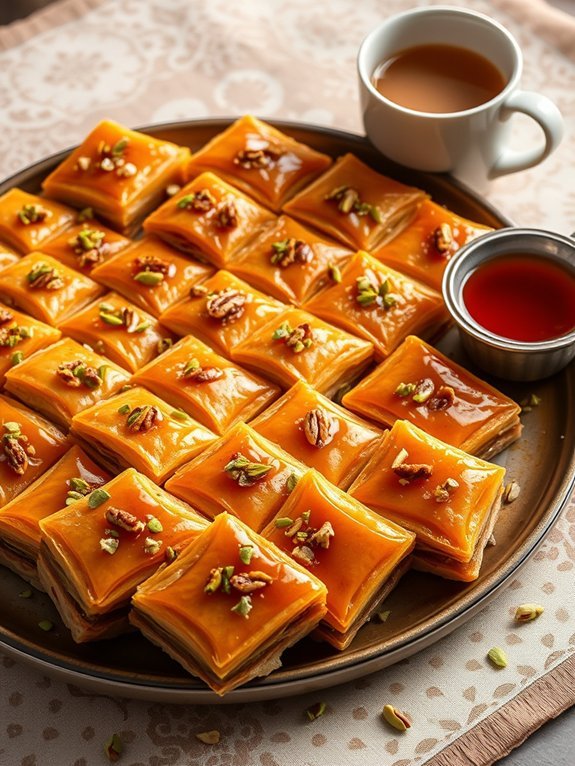
Baklava is a decadent dessert that hails from the rich culinary traditions of the Middle East. This sweet pastry is made with layers of filo dough filled with a mixture of chopped nuts and sweetened with honey or syrup, making it a popular treat for celebrations and gatherings. The contrast of the crispy phyllo with the nutty filling creates a delightful texture, and each bite is tantalizingly sweet, often enhanced with flavors such as cinnamon and cardamom.
Making baklava may seem ambitious, but it’s quite straightforward once you gather your ingredients and follow the steps closely. After assembling the layers of dough and filling, the baklava is cut into diamond shapes before being baked to golden perfection. Once cooled, a fragrant syrup is poured over it, absorbing into the layers and giving the baklava its signature moistness. Enjoy this pastry with a cup of tea or coffee for an exquisite finish to any meal.
Ingredients:
- 1 package of phyllo dough (16 oz), thawed
- 2 cups chopped nuts (walnuts, pistachios, or almonds)
- 1 cup unsalted butter, melted
- 1 teaspoon ground cinnamon
- 1 cup sugar
- 1 cup water
- 1/2 cup honey
- 1 teaspoon vanilla extract
- Pinch of salt
Preheat your oven to 350°F (175°C). In a bowl, mix the chopped nuts with cinnamon and a pinch of salt.
Unroll the phyllo dough and cover it with a damp towel to prevent it from drying out. Grease a 9×13 inch baking pan with some melted butter. Place one sheet of phyllo in the pan, brush with melted butter, and repeat this process for about 8 layers. Spread a layer of the nut mixture over the phyllo, then add two more sheets of phyllo topped with butter.
Continue layering phyllo and nuts until the materials are used. Cut the assembled baklava into diamond shapes and drizzle the remaining butter on top. Bake for 45-50 minutes until golden brown.
In the meantime, prepare the syrup by boiling sugar, water, honey, and vanilla in a saucepan for 10 minutes. Once out of the oven, pour the warm syrup evenly over the hot baklava and let it cool before serving.
When making baklava, a few important tips can help elevate the final result. Guarantee that your phyllo dough stays covered with a damp cloth as you work to prevent it from drying out and becoming brittle.
To enhance the flavor, consider adding some additional spices like nutmeg to the nut mixture. Also, letting the baklava sit overnight after pouring the syrup allows the flavors to meld beautifully, guaranteeing that every bite is moist and flavorful.
Finally, experiment with different combinations of nuts to suit your personal taste, and enjoy sharing this delightful dessert with friends and family!

